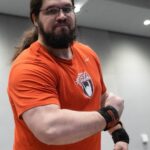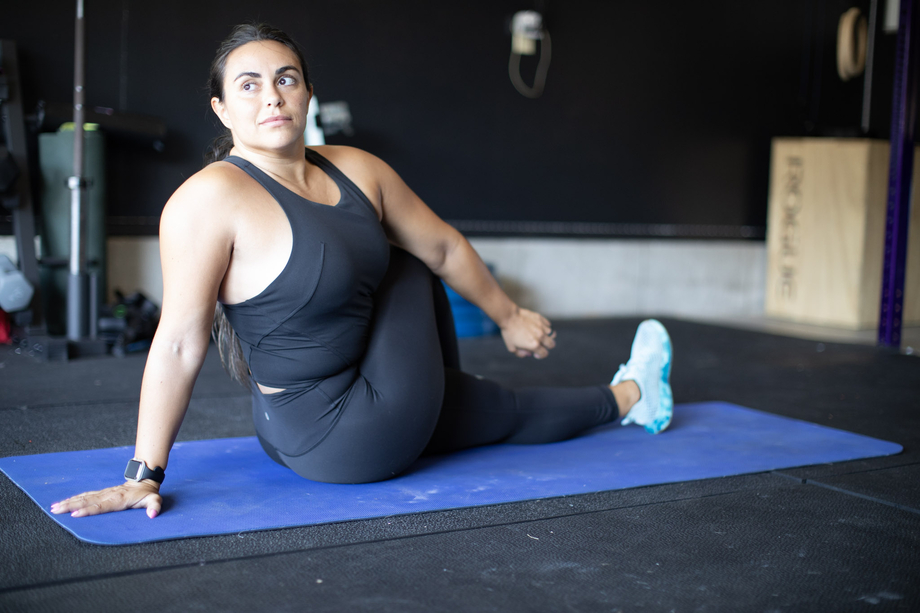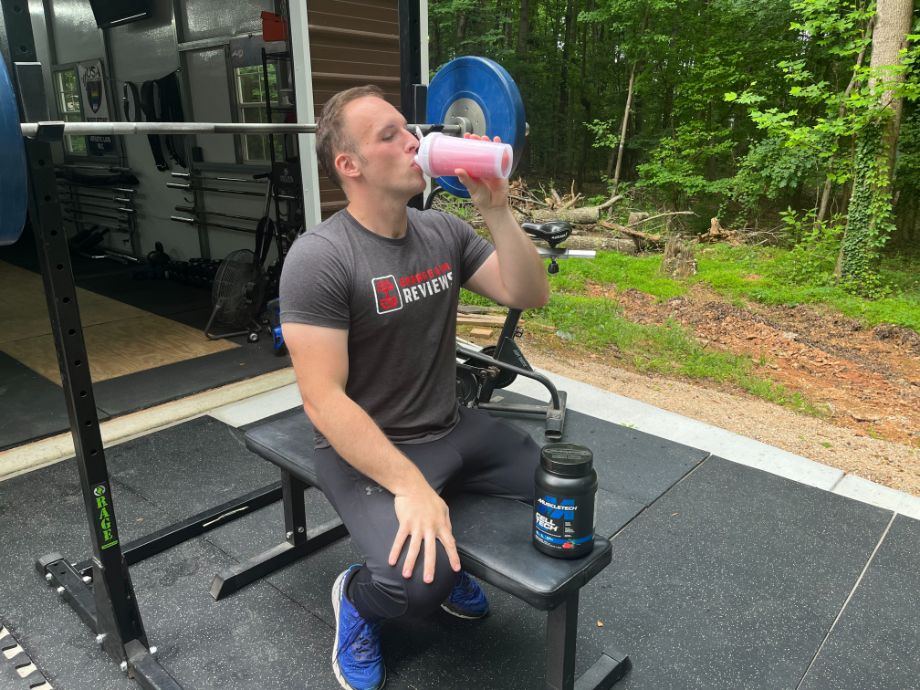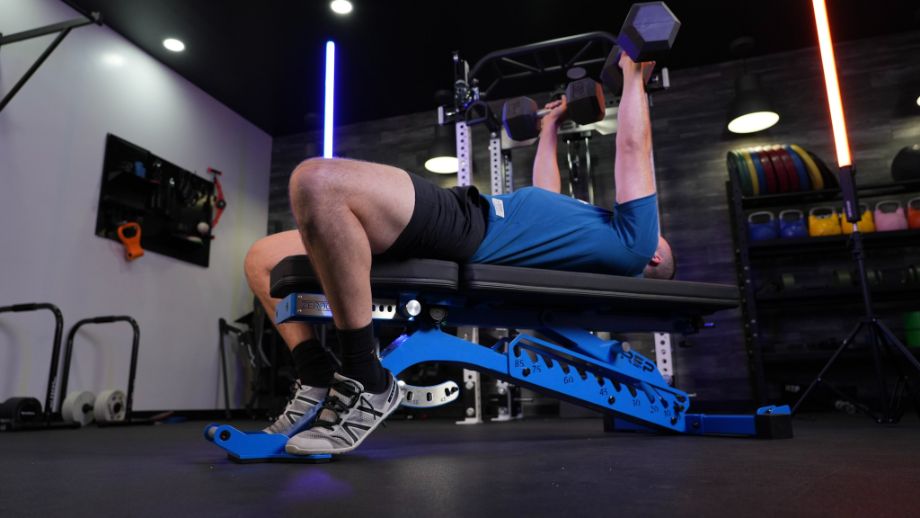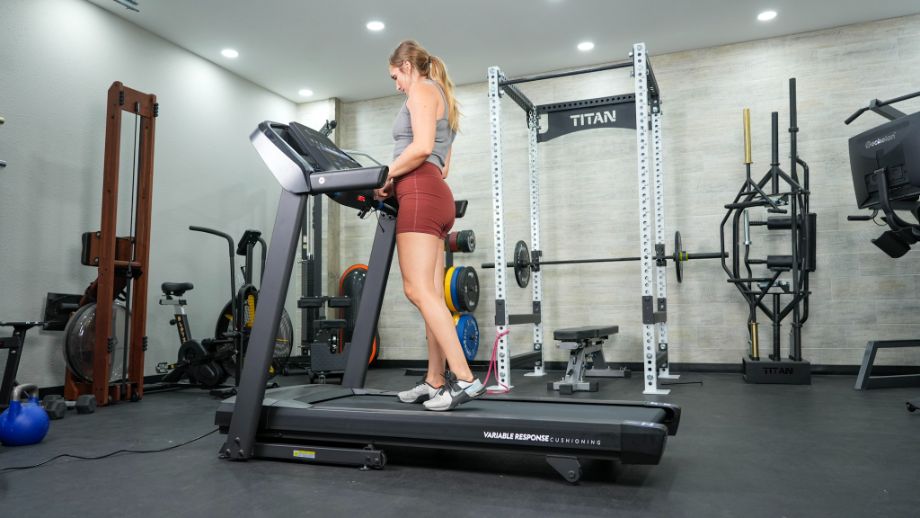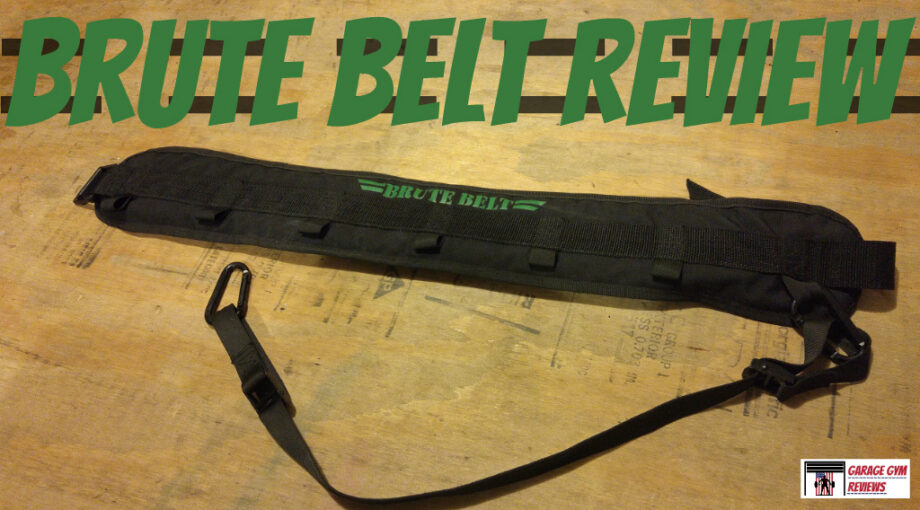We live in a modern world, which means spending a significant amount of time sitting at desks, traveling in cars, and binging Netflix series. Because of how much we sit, it’s important that your sitting muscles (aka your glutes) are both strong and flexible to allow for full range of motion during physical activity and keep chronic pain at bay.
I’m a certified personal trainer and plan to walk you through a step-by-step guide to the best glute stretches. I also think it’s important to note that only participating in regular stretching may not be enough for long-term pain relief. While stretching a muscle often feels good, you may need to focus more on reaping the benefits of strength training for relief beyond stretching.
Research shows there is a strong correlation between underdeveloped glutes and chronic knee pain1 and lower back2 and hip pain. That said, after I list out the best glute stretches, I’m going to offer a few physical therapy approved glute-strengthening exercises to help you develop a stronger backside.
Medical disclaimer: This article is intended for educational and informational purposes only. It is not intended as a substitute for medical advice. For health advice, contact a licensed healthcare professional or physical therapist.
11 Best Glute Stretches
- Lying figure-four stretch
- Seated figure-four stretch
- Pigeon pose
- 90-90 stretch
- Downward-facing dog pose
- Seated twist (Piriformis stretch)
- Half-kneeling hip flexor stretch
- World’s greatest stretch
- Knee-to-chest stretch
- Glute bridge
- Glute foam roll
Lying Figure-Four Stretch
Why do it: The lying figure-four stretch is an excellent static stretch for the glutes and tight hips. It’s gentle on your joints because your body weight won’t impact your joints.
How to do it:
- Lie face up on the floor with your knees bent and feet flat on the floor.
- Lift your left foot and cross your right ankle over your right knee, forming the shape of the number 4 with your legs.
- Thread your left hand through your legs and your right hand around the outside of your right thigh.
- Clasp your hands together behind your legs (or grab the back of your legs depending on your mobility) and gently pull your right leg toward your chest until you feel a gentle stretch in your left hip.
- Hold this position and take deep breaths for 20 to 30 seconds.
- Release your grip and repeat the same steps on the opposite side.
RELATED: Best Resistance Bands for Glutes
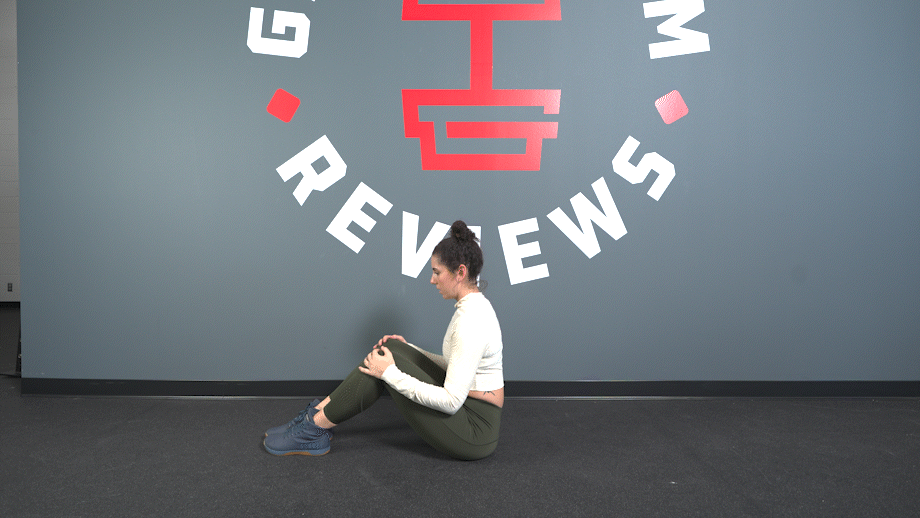
Seated Figure-Four Stretch
Why do it: The seated figure-four stretch is ideal for performing at your desk or between sets during a workout. It’s quick and easy to do and can offer relief to your low back and glutes from prolonged sitting.
How to do it:
- Sit straight up in a chair or one of the best plyo boxes with both feet flat on the floor.
- With your right foot firm on the floor, pick up your left leg, bend at the knee, until you can reach your left ankle over your right thigh.
- Keep your torso upright and gently pull your left knee toward your chest until you feel a stretch.
- For a deeper stretch, hinge from the hips to bend forward slightly until you get a stretch through your outer thigh and glutes.
- Hold the stretch for 20 to 30 seconds while taking deep breaths.
- Release your grip and repeat on the other side.
RELATED: Best At-Work Stretches

Pigeon Pose
Why do it: The pigeon pose is an excellent way to stretch gluteal muscles, piriformis, and hip flexor muscles like the iliacus and psoas muscles. It’s an advanced technique of the figure four stretch, requires fairly good mobility, and puts more strain on the joints than the lying figure four.
How to do it:
- Start by getting into a plank position, quadruped position, or downward facing dog.
- Slide your left foot behind your left wrist and lower your left knee down to the floor at a 45-degree angle.
- Once your shin and pelvis is on the floor, fully extend your right leg straight behind you and allow the top of your right foot to rest on the floor.
- Square your hips and keep your left glute slightly lifted off the floor.
- Walk your hands back to get your back straight and in an upright posture.
- In your bent leg, you will feel a stretch around the hips and glutes. In your back leg, you will feel a stretch through the hip flexor.
- Hold the pose for 20 to 30 seconds, breathing deeply.
- To release the pose, unfold your left leg and return to your starting position.
- Repeat the same steps on the opposite side.
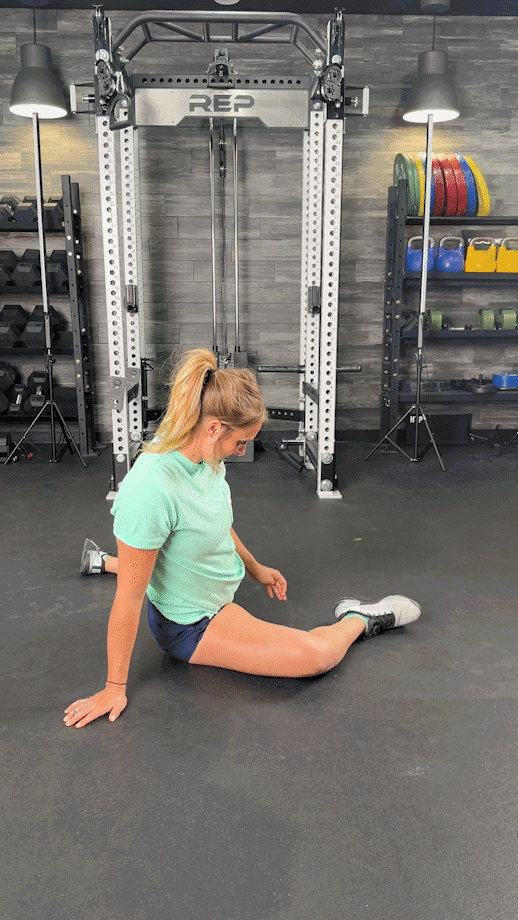
90-90 Stretch
Benefits: Pigeon pose is highly effective, but—let’s call it how it is—it can be super hard to get in and out of the pose, especially if you’re a beginner who suffers from chronic muscle tightness The 90-90 stretch offers a modified version of the pigeon pose, targeting the same key regions without requiring as much elasticity up front.
How to do it:
- Sit on the floor with your knees bent.
- Shift your weight to the right, bending your right knee as you move. Extend your left leg to the side simultaneously, bending your left knee to form a 90-degree angle as well.
- Lean your upper body forward, keeping your shoulders square and your back straight, until you feel a gentle stretch in your lower body.
- Hold for 15 to 30 seconds, then release.
- Repeat the stretch for your other side.
RELATED: Best Hip Flexor Exercises
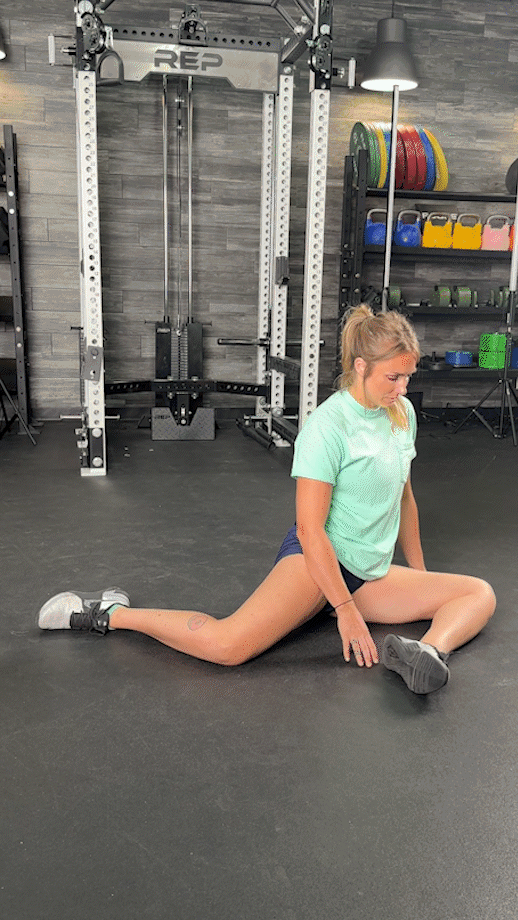
Downward-Facing Dog Pose
Why do it: Downward-facing dog offers a position that can help lengthen tight glutes and hamstrings and offer relief from sitting.
How to do it:
- Stand with your feet about hip-width apart and hinge forward, reaching your hands to the floor.
- When you begin to feel a stretch through the back of your legs, gently bend your knees enough that you can place both palms on the floor.
- With your hips high in the air, walk your hands out in front of you until your body makes a triangular shape at a 45-degree angle.
- You can hold the down dog in a static position or gently bend one knee at a time.
- Take deep breaths and remain in the position for about 30 seconds.
RELATED: Down Dog App Review
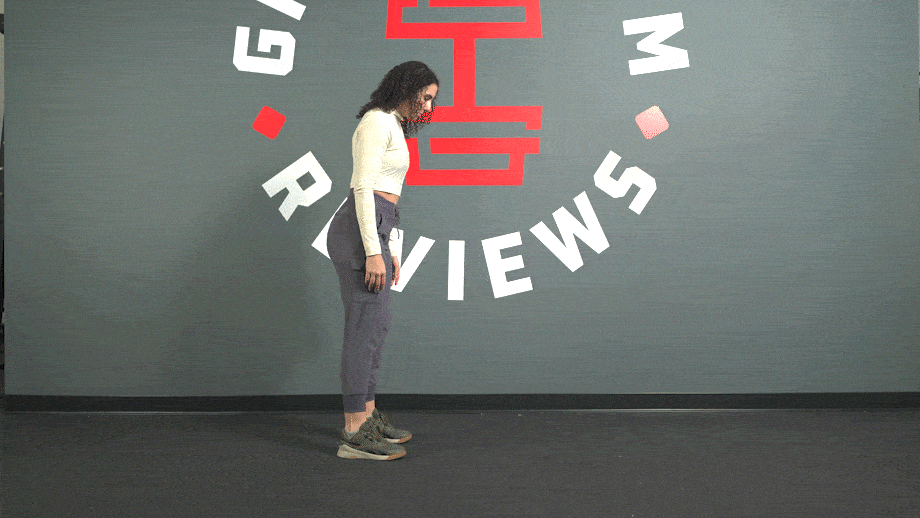
Seated Twist
Why do it: The seated twist offers an excellent static stretch for the outside of your glutes and hips. If you feel comfortable sitting on the floor with your legs extended, this is a great stretch with an added bonus of a spinal twist for extra mobility through your thoracic spine.
How to do it:
- Start by sitting on the floor with both legs extended out in front of you.
- Bend your right knee and place your right foot over your left leg so it’s on the outside of your left thigh.
- With your right hand on the floor for support, place your left elbow on the outside of your right knee as you twist your torso to the right.
- Take deep breaths as you hold the twisted position for 20 to 30 seconds.
- Return to the starting position and repeat on the opposite side.
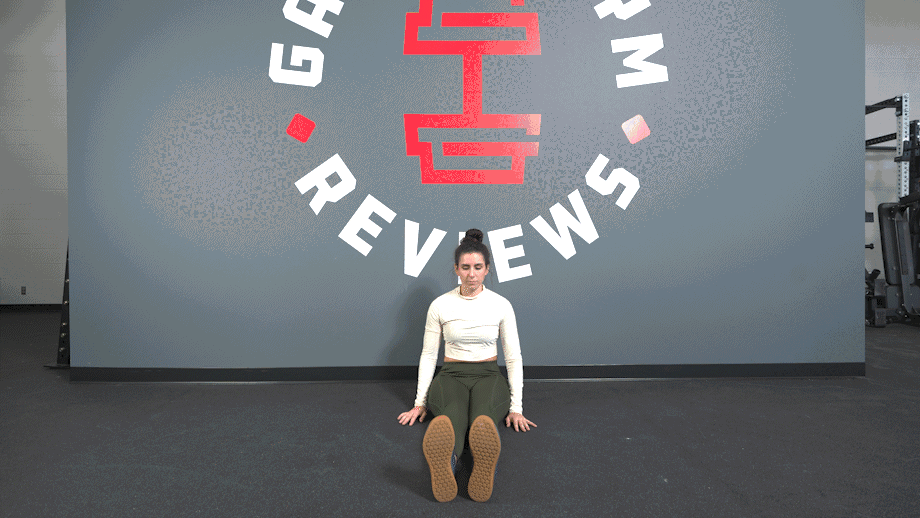
Half-Kneeling Hip Flexor Stretch
Why do it: While the half kneel hip flexor stretch is not a direct glute stretch, releasing your hip flexors may be a missing piece of the puzzle when you’re trying to find relief for tight hamstrings. Tight or shortened hip flexors—usually caused by sitting or overuse—can lead to muscle tightness or pain in the glutes.
How to do it:
- Start in a half-kneeling position with your left leg in front of you, knee bent, and right leg in a kneeling position behind you.
- With your torso upright and upper body relaxed, tilt your pelvis upward toward your belly button, scooping your glutes under your tailbone.
- Flex the glute muscle of the left leg and hold the hip flexor stretch position. You may feel a stretch in the quad as well.
- Hold for 20 to 30 seconds and repeat on the opposite side.
RELATED: How To Do The Pelvic Tilt Exercise
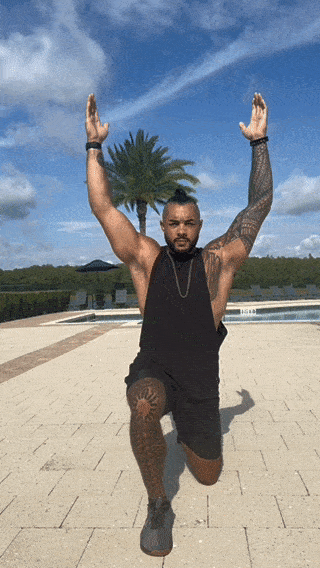
World’s Greatest Stretch
Why do it: Our experts think the world’s greatest stretch is just that—pretty great. It’s an ideal dynamic stretch to start your workouts and create blood flow and muscle activation through the entire lower body. The thoracic spine rotation makes it even more beneficial.
How to do it:
- Start in a plank position with your hands and toes on the floor.
- Step your right foot forward toward the outside of your right wrist. You can keep your back knee off the ground or gently rest it on the floor.
- Stabilize your weight on your left hand and rotate your torso and reach your right hand toward the ceiling.
- Rotate your head with your torso and hold the stretch at the top when you can’t rotate any further.
- Place your right hand back on the floor and go back to plank position to repeat on the opposite side.
RELATED: Best Mobility Exercises
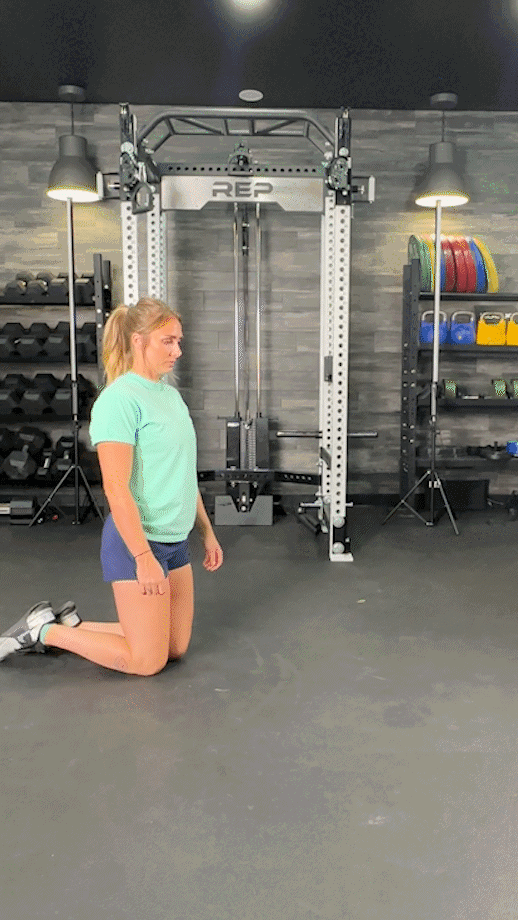
Knee-to-Chest Stretch
Benefits: The knee-to-chest stretch is classified as a “Williams back exercise,” which, according to StatPearls3, is designed to “improve lumbar flexion and strengthen the gluteal and abdominal muscles” for those suffering from low back pain. A 2021 study in the Journal of Experimental Orthopaedics4 found that regular stretching, including stretches like this one, may improve hip range of motion and reduce pain and disability associated with non-specific low back pain.
How to do it:
- Lie on your back with your legs extended and your arms at your sides.
- Lift one leg, bend your knee, and place both hands on your shin.
- Slowly pull the knee into your chest until you feel a stretch.
- Hold for 15 to 30 seconds, then release and return to the starting position.
- Repeat the stretch, this time using your opposite leg.
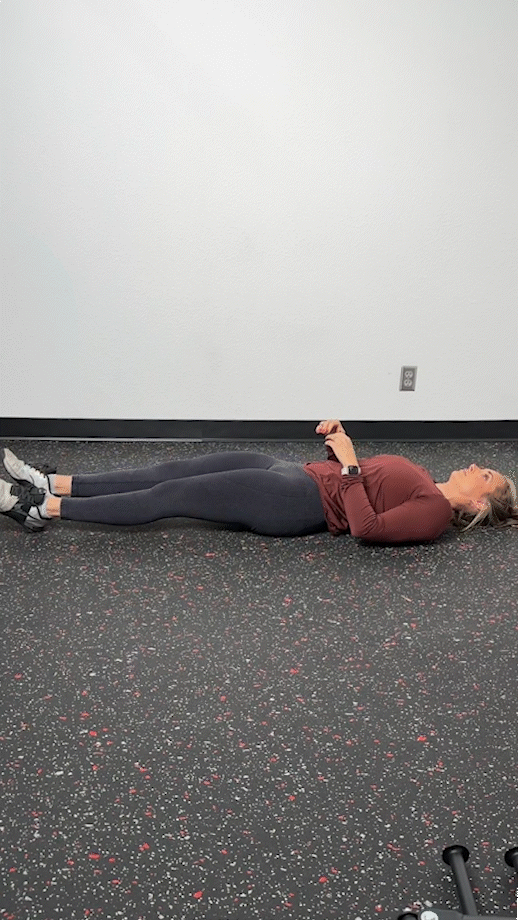
Glute Bridge
Benefits: “The glute bridge is a simple movement with tons of versatility,” says Caine Wilkes, OLY, USAW-L1, and GGR senior staff writer. “They’re great as a standalone exercise for strengthening the glutes and opening the hips, they work well as a warm-up before you get into your big lifts, and they can be turned into a unilateral exercise, so you can focus on one side at a time and correct muscle imbalances.”
How to do it:
- Lie on your back with your knees bent and your feet flat on the floor.
- Brace your core, press your lower back and feet into the floor, and lift your butt into the air until your hips reach full extension.
- Squeeze your glutes at the top.
- Release and return to the starting position.
- Repeat for reps.
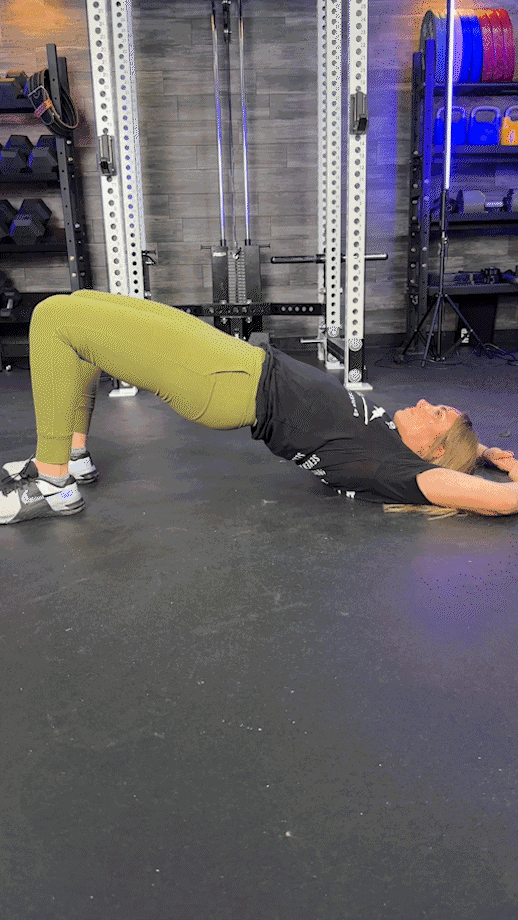
Glute Foam Roll
Benefits: The Journal of Athletic Training5 found that foam rolling “effectively reduced [delayed onset muscle soreness]” by a “moderate to large amount in the days after fatigue.” It may feel uncomfortable at first, but rolling a foam roller over those tender glutes may reduce tightness and recovery time after those tough training days.
How to do it:
- Place your foam roller on the floor and sit directly on top of it.
- Cross your left ankle over your right knee and shift your weight onto your glute muscle.
- Slowly roll back and forth for between 30 and 60 seconds.
- Switch sides and repeat.
RELATED: Best Foam Roller Exercises
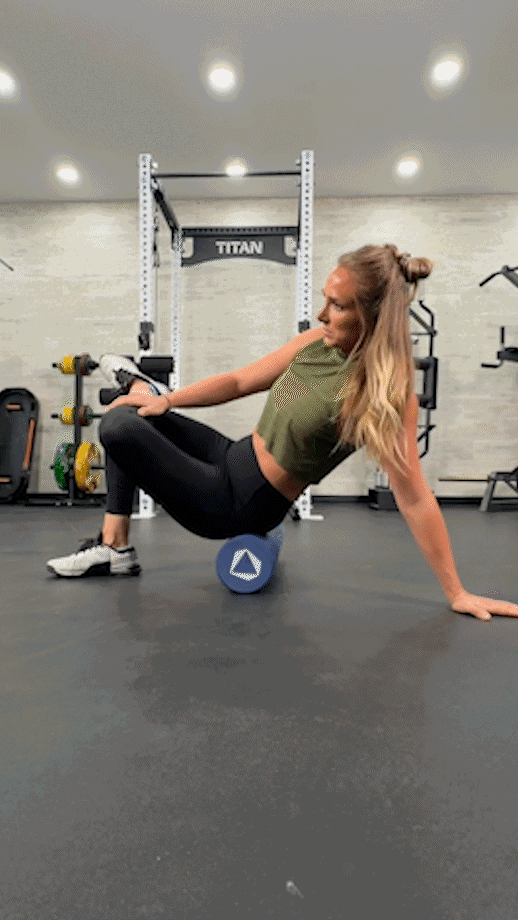
Strengthening Exercises for Glutes
As I mentioned earlier, chronic tightness may indicate you need stronger glute and hip muscles. Luckily for you, I’ve compiled the best glute exercises at home that don’t require a ton of equipment. This list includes more than a dozen exercises, but here are a few of my favorites:
- Glute bridge: Whether you’re performing glute bridges as a bodyweight warm up or loading with bands and dumbbells, it’s a low-impact and simple exercise that isolates the glute muscles for strength and size.
- Kettlebell deadlift: This deadlift variation is an excellent choice for beginners because there are a wide range of starting weights and the kettlebell can offer a more ergonomic lift than the barbell. Pretty much all deadlift variations build both hamstring and glute strength, so you can’t go wrong with deadlifts of any kind.
- Goblet squat: The goblet squat is a great all-around leg exercise. This squat variation is typically done with a deeper range of motion than a barbell squat, allowing you to work both glutes and quads when rising up from the bottom of the squat.
- Lunges: Single-leg exercises are ideal for building general leg strength and addressing left-to-right imbalances. For greater focus on the glutes, drive your body weight through your heel for more hamstring and glute activation.
- Single-leg deadlift: Practicing hip hinging with one leg can help strengthen and lengthen the hamstring and glute muscles. Plus, this is another single-leg exercise ideal for correcting strength imbalances.
Sample Glute-Focused Strength and Flexibility Workout
As a CPT, I put together a glute-focused lower body workout that includes flexibility in both the warm up and cool down. I’d suggest starting with 1 to 2 minutes of foam rolling for a gentle massage and soft tissue work on the lower body muscle groups.
RELATED: Cool-Down Exercises
After foam rolling, you’ll transition into a few dynamic stretches and glute bridges. This workout sample is followed by squats, deadlifts, and single-leg deadlifts. You’ll wrap it all up with static stretching—for this example I choose the pigeon pose and the half-kneeling hip flexor stretch.
| Exercise | Sets | Reps |
| Foam roll: glutes, hamstrings, quads | 1 | 60 sec |
| World’s greatest stretch | 2 | 10 reps, each side |
| Downward facing dog | 2 | 30 sec |
| Glute bridge | 3 | 30 reps |
| Goblet squat | 3 | 8 reps |
| Deadlift variation (kettlebell, dumbbell, barbell, etc.) | 3 | 6 reps |
| Single-leg deadlift | 3 | 8 reps, each side |
| Half kneel hip flexor stretch | 1 | 30 sec, each side |
| Pigeon pose | 1 | 30 sec, each side |
What Are the Glute Muscles?
Your buttock is made up of three main muscles: the gluteus maximus, gluteus medius, and gluteus minimus. Together these muscles function to extend and externally rotate your legs.
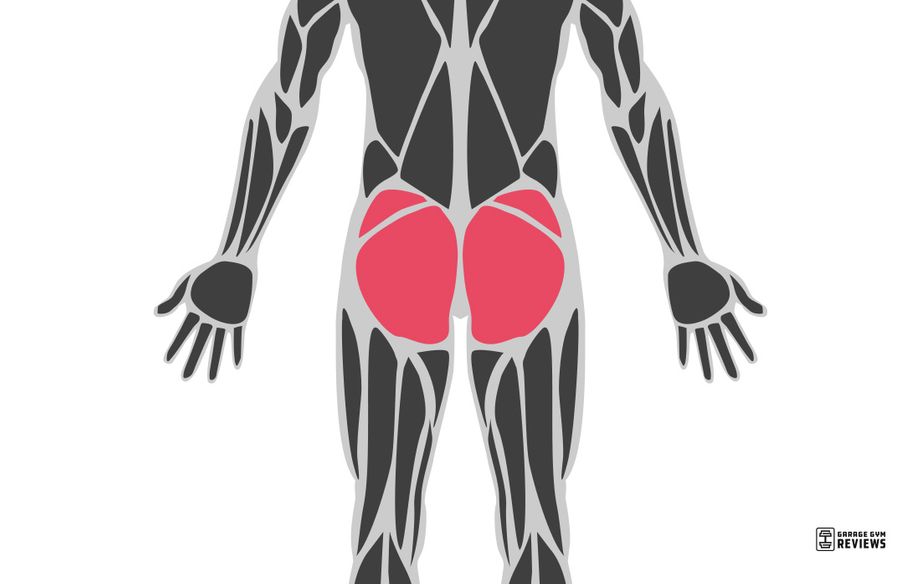
Additionally, the glutes help support your torso and stabilize your pelvis6. This means your butt muscles are responsible for helping with climbing stairs, walking uphill, running, sprinting, kicking, and rising from a seated position.
Benefits of Training Your Glutes
Strong glutes are integral if you’re looking to up your athletic game, but they’re also important for performing everyday activities comfortably and efficiently, too.
Here are some of the most fundamental benefits associated with training your glutes.
May Enhance Sports Performance
The gluteus maximus functions as one of your primary hip extensors, so literally any movement or exercise that involves extending your hips will recruit the glutes to get the job done.
According to a 2020 study in the Journal of Sports Science & Medicine7, virtually all variations of the step-up exercise, deadlift, hip thrust, squat, and lunge feature high muscle activation in your gluteus maximus. So, keeping your gluteal muscles loose and limber should translate to some #gains in a majority of lower-body exercises.
That’s not all; according to Gait & Posture8, your glutes play a major role in running economy, so runners may run more efficiently and reduce their risk of running-related injuries by focusing on their glutes.
RELATED: Strength Training For Runners
May Help Reduce Low Back Pain
Strong glutes can take pressure off of your spine and lower back, stabilizing the region and potentially providing relief for individuals who suffer from chronic low back pain.
According to the Journal of Physical Therapy Science9, strengthening the glutes “resulted in a greater decrease in low back pain disability index and increase in lumbar muscle strength and balance ability…in chronic low back pain patients.”
May Help Improve Posture
It’s easy to spend hours hunched over your work computer or phone in today’s predominantly digital society, leading to an uptick in the already widespread problem of poor posture. Poor posture wreaks havoc on the body, contributing to musculoskeletal pain and various health and medical conditions that may negatively impact your quality of life.
Thankfully, there are things you can do to correct poor posture, even in adulthood. According to a 2024 study in the Journal of Functional Morphology and Kinesiology10, several muscle groups contribute to improved posture, but “the gluteus maximus muscle apparently [played] the most important role.” This would suggest that training and strengthening the glute muscles, especially the gluteus maximus, should translate to a greater ability to maintain good posture and correct poor posture associated with muscle tightness or weakness.
Best Glute Stretches: Final Thoughts
For sore glutes after exercise, the best glute stretches highlighted above are an ideal place to start. However, if you experience chronically tight glutes and leg muscles, it may be time to consider consulting your doctor or finding a physical therapist.
Glute stretches alone may not offer long-term benefits. Stretching can offer relief to sore muscles, but if the problem is ongoing your glutes (and surrounding hip muscles) may benefit from more strength versus more stretching.
Best Glute Stretches: FAQs
How do you loosen tight glutes?
To loosen tight glutes after exercise, you may choose to start with soft tissue work using a foam roller, lacrosse ball, or massage gun. Stretching and mobility exercises like downward dog, pigeon pose, and the figure four stretch are all great ways to get relief from tight glutes.
What causes extremely tight glutes?
Chronically tight glutes can be caused from sitting for long periods of time. In a seated position the hip flexors and hamstrings are in a shortened position, which can put strain on the muscles around the hips including the glutes, piriformis, iliacus, and psoas muscles.
Overuse during strength training can also cause extremely tight glutes, but will likely resolve on its own with rest time and gentle stretching.
Should I stretch sore glutes?
If you have tight glutes from exercise, foam rolling and gentle stretching can offer temporary relief as you recover. However, if you are chronically sore, your body may benefit more from glute, hip flexor, and general lower-body strength exercises versus stretching.
References
- Barton CJ, Lack S, Malliaras P, Morrissey D. Gluteal muscle activity and patellofemoral pain syndrome: a systematic review. Br J Sports Med. 2013;47(4):207-214. doi:10.1136/bjsports-2012-090953
- Dydyk AM, Sapra A. Williams Back Exercises. [Updated 2023 May 1]. In: StatPearls [Internet]. Treasure Island (FL): StatPearls Publishing; 2024 Jan
- Hatefi M, Babakhani F, Ashrafizadeh M. The effect of static stretching exercises on hip range of motion, pain, and disability in patients with non-specific low back pain. J Exp Orthop. 2021;8(1):55. Published 2021 Jul 27. doi:10.1186/s40634-021-00371-w
- Jeong UC, Sim JH, Kim CY, Hwang-Bo G, Nam CW. The effects of gluteus muscle strengthening exercise and lumbar stabilization exercise on lumbar muscle strength and balance in chronic low back pain patients. J Phys Ther Sci. 2015;27(12):3813-3816. doi:10.1589/jpts.27.3813
- Pearcey GE, Bradbury-Squires DJ, Kawamoto JE, Drinkwater EJ, Behm DG, Button DC. Foam rolling for delayed-onset muscle soreness and recovery of dynamic performance measures. J Athl Train. 2015;50(1):5-13. doi:10.4085/1062-6050-50.1.01
- Elzanie A, Borger J. Anatomy, Bony Pelvis and Lower Limb, Gluteus Maximus Muscle. [Updated 2023 Apr 1]. In: StatPearls [Internet]. Treasure Island (FL): StatPearls Publishing; 2024 Jan-. Available from: https://www.ncbi.nlm.nih.gov/books/NBK538193/
- Neto WK, Soares EG, Vieira TL, et al. Gluteus Maximus Activation during Common Strength and Hypertrophy Exercises: A Systematic Review. J Sports Sci Med. 2020;19(1):195-203. Published 2020 Feb 24.
- Nunes GS, Pizzari T, Neate R, Barton CJ, Semciw A. Gluteal muscle activity during running in asymptomatic people. Gait Posture. 2020;80:268-273. doi:10.1016/j.gaitpost.2020.06.008
- Jeong UC, Sim JH, Kim CY, Hwang-Bo G, Nam CW. The effects of gluteus muscle strengthening exercise and lumbar stabilization exercise on lumbar muscle strength and balance in chronic low back pain patients. J Phys Ther Sci. 2015;27(12):3813-3816. doi:10.1589/jpts.27.3813
- Ludwig O, Dindorf C, Kelm S, Kelm J, Fröhlich M. Muscular Strategies for Correcting the Pelvic Position to Improve Posture-An Exploratory Study. J Funct Morphol Kinesiol. 2024;9(1):25. Published 2024 Jan 29. doi:10.3390/jfmk9010025



